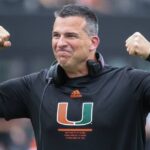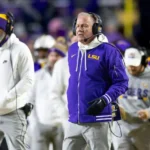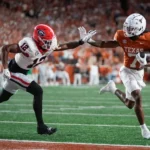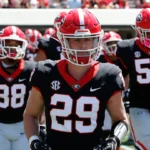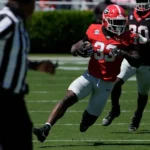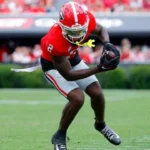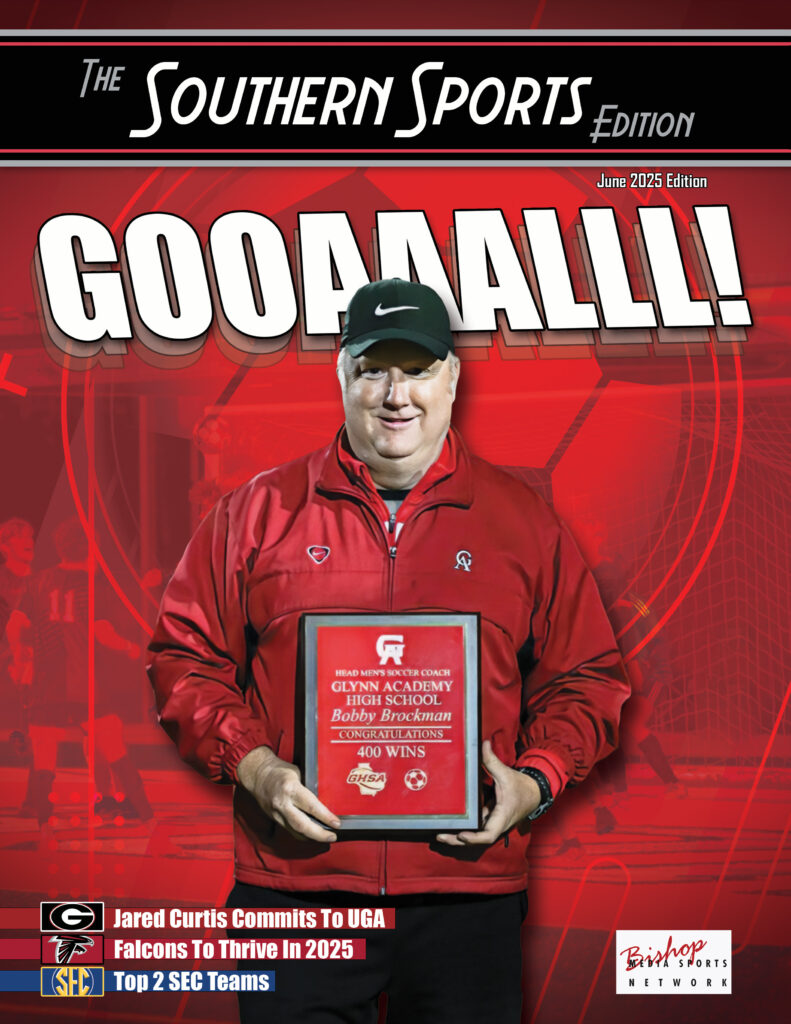College Football
Storm Brewing?
 By: Robert Craft
By: Robert Craft
TheSouthernSportsEdition.com news services
The Hurricanes won 10 games for only the second time in 20 years.
Their explosive offense led the nation in scoring (43.9 points) and produced the No. 1 pick in the NFL Draft. Still, 2024 still felt like a disappointment.
Miami’s defense was sabotage in action finishing 69th in scoring (25.3 points) and allowing 61 plays of 20-plus yards (94th nationally).
Their defensive performance was why Miami missed the College Football Playoff with a 42-38 loss at Syracuse in the final weekend of the regular season to knock them out of the conference championship.
Often praised for his recruiting, coach Mario Cristobal elevated Miami, a team who signed top 10 recruiting classes in 2023 and 2024. The Hurricanes don’t play defense, which falls on coaching.
Cristobal hired Minnesota defensive coordinator Corey Hetherman, who led a top 10 scoring defense (16.9 points) that finished 12th in yards per play allowed (4.76) in 2024. Miami gave up 30+ points in six of its 13 games last season. Meanwhile, Iowa was the only team that scored 30 points on Minnesota last year.
Miami made a concerted effort to retool its secondary by bringing in six transfers, headlined by Xavier Lucas from Wisconsin and, most recently, Houston/Auburn transfer Keionte Scott.
Miami has holes to fill on offense, too. In addition to Cam Ward, the Hurricanes lost their top four wideouts (Xavier Restrepo, Jacolby George, Isaiah Horton and Sam Brown) and tight end Elijah Arroyo.
Most notably, there was the high-profile addition of Carson Beck, Georgia’s top quarterback. Praise be the transfer portal!
Miami is very fortunate to have replaced Ward immediately and keep their momentum on offense.
In addition, Miami landed several receiver transfers: CJ Daniels (LSU/Liberty), Keelan Marion (BYU) and Tony Johnson (Cincinnati).
Beck didn’t throw in the spring while recovering from an elbow injury he suffered in the SEC Championship Game.
He’ll have to develop chemistry with a new set of receivers and acclimate to a new offense quickly — and get more help from the revamped defense than Ward did — for Miami to win the ACC for the first time and earn a Playoff spot.
The Canes NIL presence has always been well known. LifeWallet CEO John Ruiz made the Hurricanes an immediate player in the name, image, and likeness space by doling out millions to bring talent to South Florida.
While his involvement with the program has since faded given some recent financial issues, the school’s attitude towards utilizing NIL to build its roster hasn’t budged.
Miami’s NIL estimated spin for 2025 it’s between $20-$25 million.
Miami’s investment paid off on the recruiting trail where they were able to convince top prospects to spurn notable programs in order to sign with The U.
The Canes are just below Texas and Georgia for the most estimated NIL spend in the country.
Will it translate into wins on Saturday, an ACC championship and a college football playoff slot?
Top Portal Classes
 By: Kenneth Harrison
By: Kenneth Harrison
TheSouthernSportsEdition.com news services
The college football spring transfer portal window closed April 25th. Let’s take a look at the top transfer portal recruiting classes going into the summer.
#1 LSU: The Tigers are bringing in 18 players. They have 12 four-stars and 5 three-star players.
Some of the standout players are: S Tamarcus Cooley (NC State), DL Bernard Gooden (USF), S A.J. Haulcy (Houston), Edge Patrick Payton (Florida State), TE Donovan Green (Texas A&M), DL Sydir Mitchell (Texas), CB Mansoor Delane (Virginia Tech), Jack Pyburn (Florida), IOL Braelin Moore (Virginia Tech), WR Destyn Hill (Florida State), WR Nic Anderson (Oklahoma), WR Barion Brown (Kentucky), IOL Josh Thompson (Northwestern) and Edge Jimari Butler (Nebraska).
I expect LSU to be a top 10 team in the preseason poll.
#3 Miami: The Hurricanes have 19 commits. Nine of them are four-stars and 9 are three-stars.
The biggest star is QB Carson Beck (Georgia). He’s hoping to follow in Cam Ward’s footsteps because he transferred in from Washington State the year before. He was the top pick in the 2025 NFL draft.
Some of the other players are: CB Keionte Scott (Houston), S Jakobe Thomas (Tennessee), LB Mohamed Toure (Rutgers), LB Kamal Bonner (NC State), WR Keelan Marion (BYU), WR Tony Johnson (Cincinnati), TE Alex Bauman (Tulane), IOL James Brockermeyer (TCU), CB Xavier Lucas (Wisconsin), CB Charles Brantley (Michigan State), TE Jack Nickel (UAB), S Zechariah Poyser (Jacksonville State), WR CJ Daniels (LSU) and Ethan O’Connor.
The defense was the Achilles’ heel last season so they added plenty of talent on that side of the ball. I think they will start the season just outside the top 10.
#4 Ole Miss: The Rebels are adding 29 transfer players, making them one of the deepest classes. They have 10 four-stars and 19 three-stars.
They include: QB Maealiuaki Smith (Oklahoma State), OT Terez Davis (Maryland), CB Tavoy Feagin (Clemson), WR Harrison Wallace III (Penn State), WR Traylon Ray (West Virginia), OT Percy Lewis (Auburn), S Kapena Gushiken (Washington State), WR Deuce Alexander (Wake Forest) and IOL Delano Townsend (UAB).
They lost quarterback Jaxson Dart who was a first round pick in the NFL draft. They have enough talent to start the season in the top 20.
#6 Florida State: FSU showed us how badly building a team from the transfer portal can go last year.
They imploded and went 2-10 after being ranked in the top 10 in the preseason. Let’s see if things will be better in 2025. Out of their 23 commits they have 8 four-stars and 15 three-stars.
Some of them are: RB Gavin Sawchuk (Oklahoma), OT Josh Raymond (Vanderbilt), CB Jeremiah Wilson (Houston), S Jarvis Boatwright Jr. (USC), WR Squirrel White (Tennessee), DL Jayson Jenkins (Tennessee) and OT Micah Pettus (Ole Miss).
We will see if the Seminoles can bounce back.
#8 Auburn: The Tigers were 5-7 last season and only won two conference games. They have 19 commits with 6 four-stars and 12 three-stars.
This includes: LB Caleb Wheatland (Maryland), S Taye Seymore (Georgia Tech), TE Preston Howard (Maryland), OT Mason Murphy (USC), CB Raion Strader (Miami OH), WR Eric Singleton Jr. (Georgia Tech), OT Xavier Chaplin (Virginia Tech) and QB Jackson Arnold (Oklahoma).
I think they can start the season as a Top 25 team.
The Top 2 Teams
 By: Robert Craft
By: Robert Craft
TheSouthernSportsEdition.com news services
Finally, the coast is clear to make grand proclamations about the upcoming SEC football season. The transfer portal has closed (at least for departures), and there are no season-changing athletes on the market.
So, as we unwind this offseason and take a look around, here are two grand proclamations:
- The SEC’s two best teams are clearly Texas and Georgia, and in that order.
- After that, it’s wide open.
What did we expect? The two best teams are the two that made the conference championship game and were the last two SEC teams in the College Football Playoff.
It’s just the obvious conclusion, especially after a spring that saw both programs only solidify their spots, especially through the portal.
When predicting third place and onward, a glut of candidates exists and none is a clear favorite? Inevitably, some team will emerge to challenge or perhaps leapfrog Texas and Georgia, maybe there’s more than one team who does it.
At this stage, picking teams requires a confidence level that today’s facts don’t match. There are plenty of candidates with plenty of flaws among them. There will be carnage in any SEC schedule; each team saw plenty of injuries last year, and this year’s slate is essentially the same, just with the home sites flipped.
Texas and Georgia meet on Nov. 15 in Athens. They met in October last year and managed a rematch in Atlanta. That they could do so again was buttressed by their offseasons.
Texas: In perhaps the smoothest quarterback transition ever, Arch Manning steps in after two years of occasional starts for Quinn Ewers, who played well for Texas but wasn’t so irreplaceable that the NFL deigned to pick him in the first six rounds of the NFL draft.
The Longhorns then armed Manning this spring with help from the Bay Area: receiver Emmet Mosley V (Stanford) and tight end Cal Endries (Cal). These additions will pair with Ryan Wingo and DeAndre Moore returning this season, both finishing in the top five in receiving yards on last year’s team .
On defense, Texas signed five defensive linemen between the two portal periods. Right now, they have one of the best front sevens in college football, if not the best.
Between that, the projected passing game and the program’s status as the only team to make the last two CFPs.
Not to mention their surprisingly manageable schedule this year, it’s easy to pick the Longhorns as national preseason No. 1.
Georgia: Kirby Smart has never been heavy on the portal.
He prefers to use it strategically. This year’s portal haul is consistent to previous years, but this year, especially if Georgia ends up returning to the national championship game, transfers will be the reason they got there.
The post-winter window was successful enough. Georgia needed receivers and got them: Noah Thomas (Texas A&M) out wide and Zachariah Branch (USC) in the slot, plus Zachariah’s brother Zion Branch and two others for depth at safety.
The post-spring window may have been just as big.
Elo Modozie (Army) could start right away, and tailback Josh McCray (Illinois) gives the Bulldogs an experienced tailback, which was badly needed after Trevor Etienne went pro.
These weren’t eye-popping, multi-million-dollar deals, but they shored up weak spots.
Also, Georgia didn’t lose any key players in the post-spring window AND didn’t suffer any long-term injuries during spring practice.
Georgia’s roster is fortified for another national championship run, with things depending on two spots: starting quarterback Gunner Stockton and a young offensive line. The theme of spring practice was that the team feels good about Stockton.
There’s no guarantee Texas or Georgia win the conference title or even make the Playoff, but would you bet against it?
As things stand now, they are clearly the two best teams in the SEC. And the teams who emerge behind or through them will be fascinating to watch.
Well over half the league has an argument to make a push into the top tier, and that should make for a compelling season.
The Future QB
 By: Michael Spiers
By: Michael Spiers
TheSouthernSportsEdition.com news services
Jared Curtis, the No. 1 quarterback in the 2026 recruiting class, is officially back on board with the University of Georgia.
After decommitting from the Bulldogs last year, the five-star standout from Nashville Christian School made his return to the Dawgs during a commitment ceremony on May 5th that was anything but low-key.
Curtis walked into the gym early wearing a sleek all-black tracksuit, with his parents dressed in long black coats. The big moment came when he shared the news and rolled a commitment video on the big screen above the gym floor. Oregon made a serious push, but Georgia came out on top.
So why did Curtis choose to recommit to the Bulldogs? It came down to coaching. “Just the stability in the coaching staff and knowing Coach Smart and Coach Mike Bobo are there,” he said. “Those are my two biggest commitments at UGA.” Curtis said that consistency meant more to him than anything else, including NIL money.
With his commitment, Georgia’s 2026 recruiting class got a big boost, going from No. 25 to No. 17 in the national rankings. He’s the first five-star in the class for the Dawgs, but he might not be the last.
Georgia’s hoping to pair Curtis with Jackson Cantwell, a 6-foot-7, 300-pound offensive tackle and the No. 1 overall recruit in the class. Cantwell is a large human being.
If Georgia can land Cantwell too, they’d have the top quarterback and the top lineman in the country. That combination could put UGA on track to have the best recruiting class in the nation, just like when they signed Matthew Stafford back in 2006.
Speaking of Stafford, that’s the name that keeps coming up when people talk about Curtis. The comparisons make sense. Both are big, strong-armed quarterbacks who weren’t afraid to take chances.
Curtis is listed at 6-3 and 225 pounds and is known for throwing darts all over the field. He’s not necessarily a run first guy, but he moves well, throws on the run, and has serious arm talent. It feels cliché to say this, but I don’t think there is a throw he can’t make.
Also, like Stafford, Curtis has that “gunslinger” mentality. I’ve watched a bunch of his highlight reels and he is definitely not afraid to take risks and try to make something happen, even if it means forcing a throw now and then.
He had a game this past fall with a perfect stat line. In Nashville Christian’s 53-point win over rival Clarksville Academy, he went 16 for 16 with 259 passing yards and 5 total touchdowns.
If you have some time to kill, do yourself a favor and type his name into the search bar on YouTube. You can thank me later.
This cat is the kind of quarterback who can take over a game, and he’s the kind of player Georgia fans should be excited about.
In today’s college football world, five-star quarterbacks usually come with big-dollar deals. According to reports, Curtis will be part of a strong NIL package at Georgia that will include revenue sharing, endorsement deals, and collective support, but Curtis is adamant that money wasn’t the driving factor. His agent said NIL probably made up only 10-15% of the decision.
“If Jared was chasing the best compensation package, this may have been over a long time ago,” said Peter Webb, his agent.
In fact, neither Georgia nor Oregon had the highest offer. Curtis chose Georgia because of relationships, not cash.
For head coach Kirby Smart and offensive coordinator Mike Bobo, this is a massive win. They brought Curtis back into the fold and now have him leading the charge for more elite talent.
With momentum building and top recruits still on the board, the Bulldogs could be in for a huge 2026 class. It looks like Georgia just got its quarterback of the future.
Closing The Curtains
 By: Michael Spiers
By: Michael Spiers
TheSouthernSportsEdition.com news services
Spring football games used to be a big deal.
They were a chance for fans to fill the stadium one last time before summer, for coaches to evaluate their rosters in a live setting, and for recruits to catch a glimpse of what their future might look like.
Schools turned them into full-blown events with some drawing huge crowds. When Kirby Smart became the head coach in Athens, more 93,000 Bulldog fans attended his first G-Day Spring Game. But now? More and more programs are pulling the plug, and it’s not hard to see why.
The truth is, spring games just aren’t what they used to be. What started as a way to simulate game day and test rosters in real time has become something else entirely.
With transfer rules looser than ever and NIL money changing the game, coaches are starting to see spring games less as a team benefit and more as a risk to the roster.
Nebraska’s Matt Rhule put it bluntly: “I don’t necessarily want to open up to the outside world and have people watch our guys and say, ‘He looks like a pretty good player. Let’s go get him.’” The fear now is showing too much and having your players poached before fall camp even starts.
And it’s not just paranoia. It’s actually happening. Take Texas for example. Quarterback Malik Murphy turned heads during their 2023 spring game. Suddenly, SEC schools came calling. Texas threw NIL money at him to stay, but he still left for Duke after the season. And that’s just one case.
Coaches across the country are starting to adjust. Some are turning spring games into nothing more than glorified practices. Others, like Lane Kiffin at Ole Miss, have taken a different route altogether. Last year, he swapped scrimmages for hot dog eating contests and tug-of-war games. It was fun, and definitely weird, but it kept eyes off his playbook and roster depth. Turns out, Kiffin may have been ahead of the curve.
Even programs that used to thrive on spring hype are backing off. Texas, Oklahoma, LSU and USC are all scaling back or rethinking how they end spring practice.
The common thread? Everyone’s trying to protect their roster. Coaches like SMU’s Rhett Lashlee and Illinois’ Bret Bielema have admitted it: there’s more to lose than gain by putting players on display.
It’s not just Power Four teams, either. Group of Five schools, which already struggle to compete financially, are especially vulnerable. As Utah State coach Bronco Mendenhall put it, the goal now is “to protect and retain our current roster” while keeping schemes under wraps.
Sure, some programs are still holding spring games, trying to strike a balance between development and caution.
Utah’s Kyle Whittingham says they still see value in it, and he thinks that getting players real reps matters more than the risk. But those programs are becoming the exception.
There was even a push this year from Colorado’s Deion Sanders to try something new: a scrimmage against another team, like the NFL does in preseason. Syracuse was on board. The NCAA? Not so much. The idea got shut down fast.
The TV networks haven’t totally given up pushing for spring games because from their perspective there’s still some value in broadcasting a marquee program during a quiet part of the calendar. But more and more, the action is shifting off-camera.
In a constantly changing college football landscape that makes it easier than ever for players to change teams and chase the money, spring games are looking more like a thing of the past.
What once helped build excitement, evaluate depth, and keep fans engaged is now seen as an unnecessary risk in a cutthroat environment. The transfer portal isn’t going away. NIL offers are only growing. And with the pressure to keep rosters intact, most coaches are leaning toward secrecy.
Or, as Florida coach Billy Napier said: “Pick your poison. Either deal with coaches tampering, or deal with fans mad there’s no spring game.” These days, more coaches are choosing to keep the curtains closed.
Spring Buzz
 By: Kenneth Harrison
By: Kenneth Harrison
TheSouthernSportsEdition.com news services
Georgia Tech played their spring game and Team Wreck ‘Em beat Swarm 20-19 in the White and Gold game.
Starting quarterback Haynes King played limited snaps in this game. I’m sure they wanted to make sure he stays healthy. King went 5-7 for 31 yards on the first drive for Team Swarm. The drive stalled so they had to punt.
Aidan Birr made a 47-yard field goal with 7:23 left in the first quarter to give Team Wreck ‘Em a 3-0 lead.
Wide receiver Zion Taylor had seven catches for 107 yards and 2 touchdowns. Bailey Stockton had six receptions for 107 yards.
QB Aaron Philo completed a 58-yard pass to Taylor and a 17-yard touchdown pass to Luke Harpring to put Swarm within one point. Philo’s game winning two-point conversion pass attempt was incomplete.
“It’s really about just staying patient, trusting the process and now I got the opportunity to go show my abilities and what I can do,” Taylor said of his day. “I just gotta make the most of it every time I get the chance.”
QB Graham Knowles threw a 34-yard touchdown pass to Taylor with 1:40 left in the game. That turned out to be the game winner.
King completed 9 of 12 passes for 66 yards. Philo was 19 of 34 passing for 275 yards, 1 touchdown and 2 interceptions. Knowles completed 11 of 20 passes for 133 yards, a touchdown and a pick.
“Today was a perfect example of why I think it’s important to play spring games,” Tech coach Brent Key said. “There’s a lot of reasons behind it from external, fans and student body and people around, but the importance is when you go out and scrimmage and you have people in the stands, it’s a different environment. You don’t know how you’re gonna scrimmage by the way you practice, necessarily. You hope you do.
“Then you don’t know how you’re gonna scrimmage in a stadium with people in it as opposed to a stadium that is empty. Everything we’re doing trying to shrink that gap between our preparation and playing in a game. This is another step toward that.”
Freshman running back J.P. Powell scored a 1-yard touchdown early in the second quarter to give Team Wreck ‘Em a 10-0 lead. That capped of an 11-play drive.
Junior running back Jamal Haynes only had one carry but he did throw a touchdown pass. Haynes led the Yellow Jackets in rushing last season with 944 yards, 9 TD’s and he averaged 5.6 yards per carry. In 2023 he had 1,059 yards and 7 scores.
King threw a pass to Haynes in the right flat and Haynes caught it on the 45 and tossed a pass to Taylor who caught it at the 10. He dragged a defender into the end zone.
“We’re trying to build depth at quarterback,” Key joked during the ESPN livestream after the play.
Said Haynes postgame: “We put it in (Friday). We just wanted to bring a little fun to the game. Luckily, I had a great receiver to track down the ball because that (throw) was a little duck.”
“This is a reward for the players, too,” Key added. “You go through 14 days of practice, and I promise you our practices are real practice now. That’s the thing about spring; you go through all those practices and there’s no real reward other than the spring game. The reward is you’re getting better. So, give them an opportunity to go out there and play and you wanna see guys have fun, too.”
Show Me The Money
 By: Michael Spiers
By: Michael Spiers
TheSouthernSportsEdition.com news services
I don’t know about you, but college football is my favorite sport.
It’s my favorite sport to watch, it’s my favorite to talk about, and it always been my favorite to report on.
Guys used to play the game by giving all they had, dreaming of the riches that may come for those fortunate enough to play in the NFL.
The collegiate game is definitely changing and looks more like the NFL because of Name Image and Likeness (NIL) money, and the ease of changing schools through the Transfer Portal.
Nico Iamaleava’s messy exit from Tennessee might’ve just shown us what college football’s new normal is going to look like.
After trying to renegotiate his NIL deal from around $2.2 million up to $4 million for the upcoming season, Iamaleava skipped a spring practice without telling anyone.
That was the final straw for head coach Josh Heupel, and now the once highly touted QB is in the transfer portal, looking for a new team and a bigger payday.
This wasn’t totally out of the blue. Iamaleava originally made headlines back in high school with an $8 million NIL deal, setting a new bar for recruits.
But now, with top quarterbacks like Carson Beck and Darian Mensah landing $4 million deals at Miami and Duke, Iamaleava’s camp, mainly his dad and agent, wanted to get him a raise to stay competitive.
The problem? It’s April, and most teams already have their rosters set. Plus, SEC rules mean he can’t transfer within the conference and play right away.
Options like North Carolina and Tulane were mentioned, but they’ve either backed off or just don’t have the budget for a $4 million quarterback.
All this has caused a lot of debate. Holding out is a move we’re used to seeing in the NFL, not college.
But with how NIL works right now, or doesn’t work, it’s kind of inevitable. There are no real rules or structure.
Deals vary wildly from one school to another, promises sometimes fall through, and the NCAA hasn’t done much to bring order to the chaos.
Without contracts that actually mean something or rules that apply to everyone, it’s a free-for-all.
Some folks say the fix is simple: treat players like coaches. Coaches sign contracts with buyouts. If they leave early, someone pays a fee. It could be the coach or the school hiring him, but that money changes hands.
That system doesn’t stop movement, but it does slow things down, maybe even helps with renegotiations or smoother exits.
If NIL deals worked the same way, with built-in buyouts, players and schools might think twice before jumping ship or playing hardball.
But that kind of fix only works if all the major schools are on board.
If some schools do it and others don’t, players will just follow the money to the places with fewer restrictions. And as long as athletes aren’t considered employees, there’s no collective bargaining to create consistent rules.
The NCAA keeps hoping Congress will step in, but let’s be real, that’s probably not happening. And any attempt to enforce tighter rules is likely to get challenged in court, like everything else the NCAA tries.
This isn’t about blaming Iamaleava or calling players greedy. It’s about recognizing that the system is broken and something has to give.
Right now, college football is stuck in this weird space where players have more power than ever, but the infrastructure hasn’t caught up.
Boosters and collectives are throwing around big money, but without guardrails, stories like this will keep popping up.
Iamaleava might not get the deal he wants this time around, but more players are going to try. This isn’t the end of college football, but it is a sign that the game’s rules, both on and off the field, are changing fast.
It’s time to stop reacting with shock every time something like this happens and start figuring out real solutions.
Taking Off The Jersey
 By: Robert Craft
By: Robert Craft
TheSouthernSportsEdition.com news services
Nico Iamaleava’s name will go down in college football history as one that created a turning point for players in multiple ways.
Which part fans remember might depend on how the rest of Iamaleava’s football career plays out.
As he prepares to enter the transfer portal amid a public breakup with Tennessee about name, image and likeness re-negotiations, this first-of-its-kind NFL-style holdout situation was possible only because of what had come before it.
Iamaleava once again has brought college football a lot closer to … whatever its future will be. His NIL deal going public before enrolling at Tennessee and the legal defense of it led to more money for players. Iamaleava gave a lot more leverage to the players by knowing the value of college athletes.
On the other hand, his public breakup with Tennessee gave leverage to the universities. Had Tennessee and its collective balked or hesitated, more stars might’ve started public holdouts. Instead, Vols fans backed coach Josh Heupel, and players are anticipating that fans won’t be on their side.
It started in 2022, an $8 million multiyear for Iamaleava while he was still in high school.
It was one of the first sets of public NIL numbers, and this caught more attention from the public because Iamaleava hadn’t played a single down of college football.
When the NCAA looked into it, the state of Tennessee’s attorney general sued the Tennessee collective, leading to a settlement that allows boosters to negotiate NIL with athletes and their agents before players enroll.
Both of those situations will likely lead to more millions going to players. The public contract leak in 2022 reset the market for active players and recruits and has removed the possibility of universities underpaying athletes who are inexperienced in negotiation.
The AG’s lawsuit opened the door to more direct NIL conversations with recruits. Cracking the NIL and creating a more lucrative space for athletes is part of Iamaleava’s legacy.
That is why the whole idea of calling this “NIL” remains farcical. The millions and millions spent on players for NIL come from boosters, local business owners, and rich alumni who want these players to represent their business the same way they represent their university.
This has created tension between regular fans, who don’t care about any individual’s success, they just want to see their team win…
College football is a transient sport; because of that fans root for a team more than a player because the players are only there for 4 years MAX.
The NCAA was able to keep up amateurism and cheat athletes for so long. The NCAA has purposely made the unionization of players hard on the principle that fans, more often than not, will show up on Saturdays no matter who’s on the field, even if they’re showing up with paper bags on their heads.
That reminder is the message coming out of Iamaleava’s impending divorce from Tennessee. Tennessee was one of the only states in America that never outlawed sharecropping, and their slave-owner mentality with college athletes is what bit them in the ass financially and on the field.
There is no college football without college athletes, and there is no excellence in college football without excellent college athletes.
The story is far from over. Perhaps Iamaleava finds a new home, continues to succeed, and earns whatever amount of money he’s worth.
Perhaps Tennessee can’t find an adequate replacement internally or in the portal and struggles in 2025.
The Vols appear willing to live with the potential consequences of fumbling a world class athlete, and the fans support being a worse team in 2025.
Players are worth what organizations are willing to pay them. That’s basic business. This breakup is a reminder that it only goes so far.
G-Day
 By: Kenneth Harrison
By: Kenneth Harrison
TheSouthernSportsEdition.com news services
The Georgia Bulldogs recently played the G-Day Spring game. That is significant because some programs like Nebraska have chosen not to play a spring game.
With the transfer portal some teams say that causes other programs to poach players. That is why the UGA spring game was not televised.
This game featured the Red Team (No. 1 offense/second team defense) against the Black Team (No. 1 Defense/second team offense). The Red Team won 34-17. The announced attendance for the game was 35,003.
The offense had 88 pass attempts and just 44 rushing attempts. Gunner Stockton took every rep with the first-team offense in the first half. Defenders aren’t able to hit the quarterback, while it often plays very vanilla coverage and rarely blitzes.
Projected starting quarterback Gunner Stockton passed for 309 yards, 2 touchdowns, 1 interception and he completed 50% of his pass attempts.
Backup QB Ryan Puglisi had 49 pass attempts. He was inconsistent but he did throw a touchdown pass to Colbie Young on his first chance playing with the starting offense. He did throw an interception that was picked off by Dominick Kelly shortly before halftime.
Third-string quarterback Colter Ginn led a touchdown drive to start the second half. He threw a seven-yard TD to London Humphrey’s.
“Some good and bad for both, but that’s the way spring games go,” Kirby Smart said. “We’ve got to play some loose plays, throw the ball around, got to do some two-minute.
Excited about the guys that got to play. We’ve got a lot of work to do in terms of offseason and getting ourselves where we need to be for next year, but a lot of the mid-years got valuable minutes. I can remember when mid-years kind of went with the threes and fours, and now it seems like more of them are going with the twos.
“That’s just the way of college football right now.”
The defensive backs looked good in this game. Daniel Harris prevented a deep pass to Noah Thomas on the opening drive. He intercepted Stockton in the end zone later in the first quarter.
The leading receiver for the first-team offense was Dillon Bell. He had 5 receptions for 78 yards. He also had a 13-yard rush to showcase how versatile he is. Junior London Humphreys had 4 receptions, 77 yards and 2 touchdowns.
“London’s very smart,” Smart said of Humphreys after the scrimmage. “He doesn’t have a lot of anxiety, he’s very mature, and he’s good for those kids in that (group) because he works really hard.”
Kicker Peyton Woodring made field-goal attempts of 44 and 35 yards. Liam Badger made a 23-yard field goal.
The offensive line was missing Monroe Freeling and Daniel Calhoun, as both recover from injury.
The defensive line is very young and they were in a tough position dealing with 88 pass attempts. They lost a lot of talent to the upcoming 2025 NFL draft so they need to gain more experience.
“We (have) got to get better,” said Smart when asked about all the redshirt freshmen playing on the offensive and defensive lines.
The Bulldogs will open the 2025 season August 30th at home against Marshall.
Wrong Turn
 By: Robert Craft
By: Robert Craft
TheSouthernSportsEdition.com news services
Georgia Bulldogs wide receiver Nitro Tuggle was arrested early on March 25 on two misdemeanor charges: reckless driving and speeding-maximum limits.
He was booked into Athens-Clarke County jail just before 2 a.m., with his bond set at $26.
Georgia announced that Tuggle has been suspended indefinitely. He will be a sophomore this season and has become one of many UGA football players to be arrested on driving-related charges.
Georgia also announced that Marques Easley, a second-year offensive lineman, is suspended indefinitely. Easley was charged with misdemeanor reckless conduct after crashing in front of an apartment complex with no injuries.
The situation involving Georgia offensive lineman Marques Easley has taken another turn.
Easley was arrested in Oconee County on Friday and was charged with reckless conduct and reckless driving. According to jail records, the 19-year-old was booked at 4:35 p.m. on Friday and released at 5:04 p.m. on a $1,000 bond. The details regarding Easley’s class were made public on Friday.
According to the crash report from the incident, Easley’s 2021 Dodge Challenger was traveling west on Redwood Lane in Watkinsville in what the reporting officer described as “a reckless regard” on Monday.
Easley lost control of the vehicle, which began to rotate clockwise and run off the roadway before striking a power distribution box with its front. The vehicle then struck the passenger side of a second vehicle — a 2013 Hyundai Elantra — with its driver’s side.
Per the report, that impact caused the Elantra to strike a third vehicle — a 2018 Mercedes Benz CLA — with its driver side.
The Challenger’s impact with the Elantra caused the Challenger to hit the front of 1313 Redwood Lane with its front before it came to a final rest.
Per the report, Easley told the reporting officer he lost control of the car while “traveling between 25-30 MPH prior to the crash.” The crash report states that “the investigating troopers found this to be an inaccurate account of [what] happened due to the amount of damage from the crash and the fact that [Easley’s Challenger] had tire marks going back an estimated 200 feet.”
“The tire marks were consistent with a vehicle laying drag,” the report stated.
Easley was taken to Piedmont Athens Regional due to the accident, though the details of his injuries were not listed in the crash report.
A second Georgia player — cornerback Ondre Evans — was listed on the crash report among the six occupants involved. Evans was not taken to the hospital following the accident.
The crash report states that Easley was given three citations for the incident: one for reckless driving and two for reckless conduct causing harm to or endangering the bodily safety of another.
Easley’s arrest is the 10th known arrest of a Georgia football player for driving-related offenses since the big incident in January 2023: player Devin Willock and staffer Chandler LeCroy were killed in a high speed car accident.
LeCroy was found to be over the legal drinking limit and racing with Jalen Carter, who pleaded no contest to two misdemeanors and therefore did not serve any jail time.
Coach Smart said last summer that the program was doing several things to limit, then eliminate these persistent driving issues with players.
Guest speakers have made several appearances to the team and Georgia’s collective is set to withhold payments to the players. Smart called the fines “substantial”.
